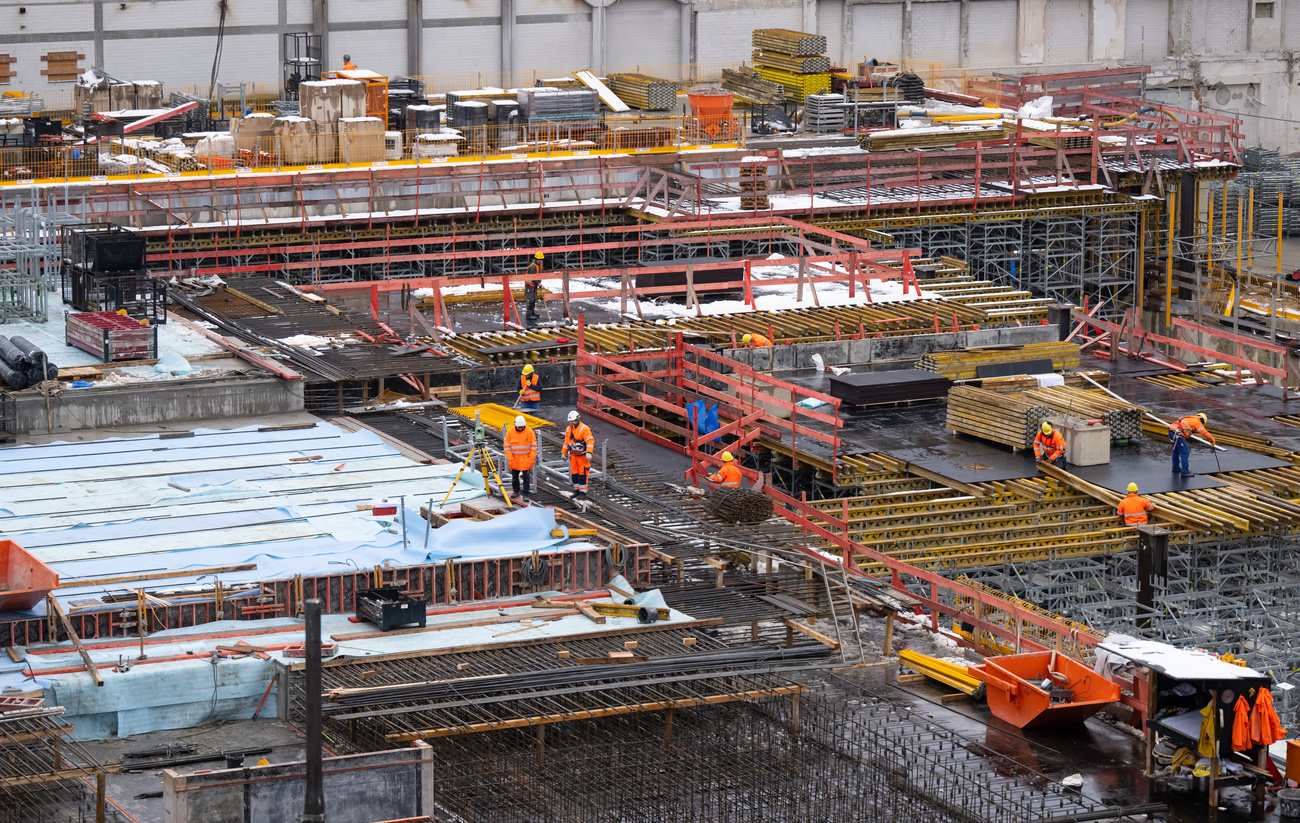How countries are managing immigration between economic needs and social tensions

In many developed countries – Switzerland among them – population growth is now essentially fuelled by immigration. The issue is increasingly divisive, and likely to become even more so, as ageing populations and labour shortages could spark even more immigration in the future. This begs the question: is there a “right” threshold for immigration? Here are some facts, figures and insights from demographers.
Ageing societies where fewer and fewer children are born: the “demographic winter” is coming or is already here – in many developed countries. This is particularly true in Europe and East Asia, where immigration has become a major driver of population growthExternal link.
This article is part of a series on the major demographic challenges that lie ahead. The future of international migration, and its link with ageing populations, is one of them.
Immigration policy and the integration of immigrants are hot topics in Switzerland – as they are in most developed countries, which are mainly host states. Governments are having to find a balance between the need for labour and opinions that are increasingly hostile to immigration.
Nearly all countries are likely to be affected in the coming decades, with the exception of sub-Saharan Africa, according to United Nations projections.
In some countries, such as Germany, Spain and Portugal, an influx of foreigners has only just prevented demographic decline in recent years.

More
Fertility rates plummet in Switzerland – and beyond
In others, such as Japan, Italy and Hungary, low immigration has only cushioned depopulation.
Switzerland, like Canada, is in a different situation. Immigration more than makes up for the low birth rate (which has fallen to 1.3 children per woman in both countries), and their overall populations are growing rapidly.
Since 2013, the number of inhabitants in the small Alpine nation has risen by almost 10%. In 2024 it topped the nine million mark. Net immigration accounted for 95% of the record demographic growthExternal link (+147,000 people) registered in 2023.
Although births still outnumber deaths, natural population change could, however, swing into the negative by the end of the decade, according to the UN.
Switzerland has known high levels of immigration since the end of the 19th century. There have been three major successive waves: the industrialisation phase up to the First World War; the economic recovery of the mid-20th century, with a peak in the 1960s; and the current era of free movement with the European Union (EU) and globalisation since the early 2000s.
Until then, the arrival of foreign workers was governed by bilateral agreements and temporary residence permits. Whenever there was an employment crisis, immigration was drastically curtailed.
The introduction of free movement with the EUExternal link in 2002 sparked a sharp increase in the arrival of European nationals, who today represent more than two-thirds of foreignersExternal link established in Switzerland (1.5 million people out of 2.3 million). Immigration from non-EU countries remains subject to quotas.
Switzerland also has a long tradition of welcoming refugees and more than 130,000 people were in the asylum procedure External linkat the end of 2024. Today it is one of the countries with the highest proportion of immigrants in the world: 36% of the population was born abroadExternal link, and more than one quarter has a foreign nationality.
In Canada, meanwhile, “net immigration has soared over the last four years”, says Quebec demographer Guillaume MaroisExternal link, a researcher at the International Institute for Applied Systems Analysis in Austria and professor of demography at the Asian Demographic Research Institute of Shanghai University.
Between 2022 and 2023, the Canadian population grew by 3%External link (nearly 1.2 million people), the highest rate of any Western country; and 98% of this increase stemmed from net international migration.
Fear of being overrun
But when such levels are reached, is this too much immigration? The question lies at the heart of political debate in Switzerland and has been a major stumbling block in the country’s relations with the EU.
In Canada, a nation built on immigration, “no major party supports ‘zero immigration’,” says Marois. “But the question of whether we should continue on our present course has been raised for several years.”
The fear of being overrun, or even “replaced”, is shared by other traditional host countries. This is the case in the United StatesExternal link and the United KingdomExternal link, as in almost all developed countries. Over the past decade, immigration has increased by 20%External link in the OECD area. In Switzerland today, preventing “overpopulation” is the stated goal of the right-wing Swiss People’s Party – the country’s leading political force – in advocating restrictions on immigration. Its latest people’s initiative, which will be put to a national vote, calls on the government to set a cap on immigration if the population nears the 10 million mark before 2050.
The party’s arguments skim over the economic impact of immigration in Switzerland. There is little question today that freedom of movement has generally met the needs of the labour market so far.

More
How free movement impacts the Swiss economy
Instead, the People’s Party blames “massive immigration” for “almost all of Switzerland’s woesExternal link” with regard to social cohesion (e.g., the disappearance of Swiss values or the crime rate), but above all to quality of life: the decline in per capita income, the lack of affordable housing, the congestion of transport infrastructure, the rise in energy consumption, and more construction in the countryside.
This linkage between strong demographic growth and overuse of resources is not new; nor is it limited to the nationalist right. Ten years ago, it was already at the heart of an initiative by the environmental group Ecopop, which advocated curbing immigration for the good of the environment and was supported by personalities from different walks of life (in particular ecologists).
Although the initiative was squarely rejected in 2014, fears linked to the sharp increase in population have not waned. Today, more than half of the Swiss electorate wants to limit immigration for these reasons, according to a recent pollExternal link on the subject. Even economic circles are now calling for measures to “deal with the problems caused by immigrationExternal link”.
In Canada, too, a severe housing crisis in the cities – where most of the foreign population is concentrated – is stoking debate about the need to lower immigration thresholds. While overpopulation is not really a problem in this huge country, a call by business leaders to increase quotas in order to bring Canada’s population to “100 million by the end of the century” has generated significant backlash.
Nearly 60%External link of Canadians today believe that the country takes in too many immigrants. Last October, Ottawa announced its first-ever plans to reduce its targets for permanent resident admissions by over 20%External link from 2025.
Problems with multiple causes
While there is no doubt that excessive population growth can have undesirable consequences, many demographers consider it simplistic to establish a causal link between these problems, which are multifactorial, and immigration.
As Philippe WannerExternal link, professor at the Institute of Demography and Socio-Economics in Geneva, points out, some immigration occurs precisely because of a need for infrastructure (new housing is often built by foreign workers, for example) and arbitrarily limiting it could thus have even more serious consequences. Meanwhile, an article External linkfrom the Canadian press, looking at the many causes of the housing crisis, argues that one exacerbating factor is, precisely, the labour shortage.
The very idea that infrastructure has reached saturation point is also a matter of debate in Switzerland. “Economic and social well-being indicators are high,” notes Wanner, “which may reflect the fact that, for the time being, demographic developments are not a problem”.
“There is no doubt that there is a limit, but it is a long way off,” Michel OrisExternal link, a demographer at the University of Geneva, told Swiss public television (RTS) last year. He said that the pressure on infrastructure certainly was “a problem that must be tackled; but it is a ‘a rich nation’s problem’”, adding that the most densely populated country in the world today is Bangladesh. According to Oris, Switzerland’s current problems are “those that [it] did not deal with well ahead of time and stem from a lack of anticipatory investment”.
Furthermore, says Gianni d’AmatoExternal link, a professor of migration studies at the University of Neuchâtel, when immigrant populations settle down for the long term, “there are benefits, but there are also costs”. He adds: “The question is to what extent there is a political will to invest.”

More
‘If we plan smartly, there’s room for 10 million people’ in Switzerland
Is there an immigration threshold?
Many demographers believe it makes little sense to establish a threshold beyond which immigration cannot be “absorbed”. Existing integration policies, the profiles of the people concerned (origin, language, culture), their match with labour needs and the geographic areas where they settle are all major contributing factors which vary greatly from one country to the next.
According to the Canadian demographer Marois, two conditions determine successful integration into the labour market. These are “low unemployment and ‘good jobs’ for immigrants” – in other words, decently paid work that helps prevent wage dumping, contributes to public finances and promotes social integration.
In this regard, countries that practise selective immigration based on skills (such as Canada), and those that mainly welcome skilled immigration from the EU (Switzerland and Luxembourg), are among those with the best integration indicatorsExternal link, according to the OECD.
In addition to the efforts made to integrate migrants, co-existence with the local population also depends on the latter’s attitude towards the newcomers. However, according to the Gallup World PollExternal link, which tracks the most important issues worldwide, acceptance of migrants is declining in most countries. In 2020, the year of the last survey, Canada came out on top, while Switzerland, although still quite high up, had slipped sharply down the ranking.
In Switzerland, as Wanner explains, “the migrant population has relatively similar cultural characteristics”, which has so far helped to avoid the phenomena of ghettoisation and rejection. This does not mean, however, that social cohesion issues may not arise in the future.
Although the concept of a “tolerance threshold” is unquantifiable and in itself contestedExternal link, “this does not mean there is no such thing as intake capacity”, Marois says. “I believe that it is exceeded when the subjective expectations of the population, both immigrant and non-immigrant, are no longer met.”
And these expectations depend very much on the ideas on which nations are built, notes d’Amato of the University of Neuchâtel. “If there is a will to do so, immigration can rise to impressive levels. The Arabian Gulf societies, for example, function with almost 90% immigrants. Meanwhile in a country like Japan, even a small number is already too much.”
Tougher stance or eased restrictions
Nevertheless, while some countries are seeking to take a tougher stance on immigration, Japan recently decided, for the first time in its history, to ease certain visa restrictions. The aim is to attract more foreign workers to help address the challenges of a rapidly ageing population.
The same reasons have prompted South Korea to offer better incentives to highly skilled migrants, and Spain to announce that it will grant legal status to around 900,000 undocumented migrantsExternal link over the next three years, despite internal opposition.
Other ageing developed countries may decide to follow suit in the years ahead, as labour shortfalls are expected, especially in key sectors such as healthcare.
In a report on the future of migrationExternal link, the US National Intelligence Council points out that “destination countries […] probably will reap economic benefits that outweigh the fiscal costs of new migrants”, if they can manage the social and political tension caused by immigration.
What is your opinion? Join the discussion:
Edited by Samuel Jaberg/adapted from French by Julia Bassam/gw

More
Newsletters

In compliance with the JTI standards
More: SWI swissinfo.ch certified by the Journalism Trust Initiative













You can find an overview of ongoing debates with our journalists here . Please join us!
If you want to start a conversation about a topic raised in this article or want to report factual errors, email us at english@swissinfo.ch.